The 3" bible - part I
Introduction
With the risk of boring visitors, presenting wrong information or causing other mishap, I herewith present an attempt to solve some of the mysteries of the 3" disk. The history of the Panasonic 3", which was a competitor for the Sony 3.5" back in the 1980's was rather short: only the Acorn Einstein and several Amstrad models (the CPC and PCW series) were equipped with drives of this format. Not because it was a bad drive, simply because Sony has more marketing power and the Panasonic had one disadvantage compared to the 3.5". You cannot distinguish which way is up or down, as you can with the 3.5". In fact a 3.5" drive will not allow the disk to be inserted up side down, a problem that sometimes occurs with the double-sided 3" disks.
The reasons for Alan Mike Sugar Trading (yes: abbreviated to AMSTRAD) were the facts that Panasonic offered them cheaply and that they did not consume much power. Particularly in the PCW 8256/8512, with its vulnerable power supply construction, this was a useful thing… When the PCW became very popular, the supply of disc drives exhausted and the market demanded the implementation of a standard format Amstrad finally provided their later models with the 3.5" disc drive. The Panasonic 3" never really made it into the market and, although the hardware was cheap, the disks itself were expensive. Quite a lot of 3" discs were produced though, either white-label or branded. These pages provide both an insight into the technical details and tips for the 3" as well as a listing of the various brands of 3" disks.
Do note, however, that these pages are not yet complete and subject to many changes. I still need to check and complete them…
The inside
A 3" disk basically resembles the other disc formats, like the 3.5" and the 5.25", here is what they look like from the inside.

A Maxell disc (recognisable by the red horizontal R/W -read/write- slides: the other type is the vertical R/W slide as used in the Panasonic disc and look-alikes) cut in halves and with the floppy disc removed. Basically the disc contains of two black plastic plates, two white pieces of felt, two metal shutter plates, two red plastic R/W slides, a plastic rod and a spring (both on the left panel, right corner).
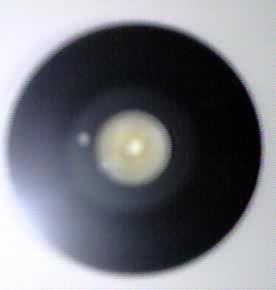
And, of course, the floppy disc itself which is used for the actual storage of data. The hole on the left corresponds to a hole in the right part of the cover plate (above) and is used to identify the position of the disc. The white plastic ring in the middle, the hub ring, is used by the drive to rotate the disc and to get to requested part of the disc in front of the cleft of the cover plates (the right cover plate shown above has the metal shutter plate in the open position - the left one is closed). The pieces of felt (cheaper brands do not have these) prevent wear, dirt and noise. The read/write head of the drive actually moves up and down only, while the R/W slides indicate the drive whether it may write on the disc or not.

The smaller parts of the disc: the white plastic rod (top) which opens the meal shutter plates (one shown) when the disc is inserted into the drive, one of the two red R/W slides and the metal spring that keeps the rod in the closed position when the disc is not in the drive.
Brands
A variety of manufacturers have produced the 3" disc, either under their own name as well as other brand names (e.g. Panasonic has produced label-discs for Tandy, Amstrad/Schneider, Dixons and others) and white label (no brand).
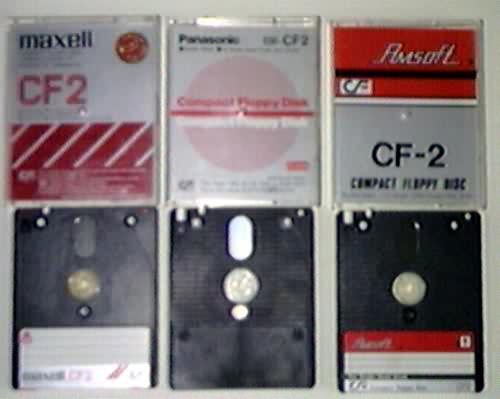
From the left to the right: Maxell old batch (plastic case), the original Panasonic (plastic case) and the Amsoft (old batch: a Panasonic too, in plastic case). All of them of good quality. This picture clearly shows the smooth surface of the Maxell and the rectangular patterned surface of the Panasonic. Together with the type of read/write slides it is the best method to identify a disc.
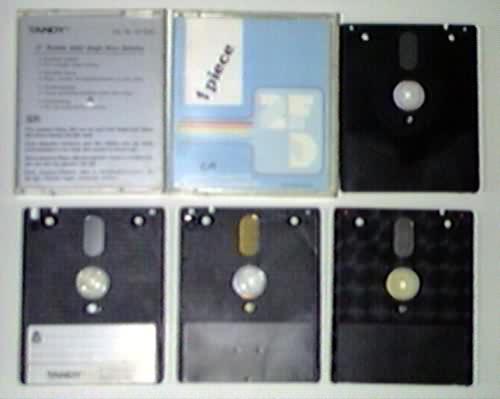
From the left to the right: Tandy (also a Panasonic, plastic case), a white-label disc (Panasonic styled rectangular patterned surface, Maxell styled R/W slide, brass coloured shutter, two typical indents on the label-surface, large plastic case - mediocre quality). The other two are also white-labels.
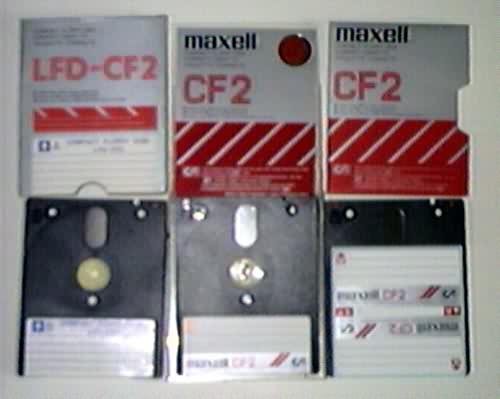
From the left to the right: Godexco (cardboard case, Maxell type R/W slide, mediocre quality), Maxell in vertically opened plastic case (old batch) and Maxell (new batch, sealed carbon case, label not yet glued - these can still be obtained nowadays).
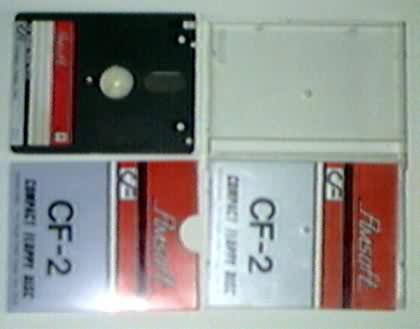
Two Amsoft casings: the new style (soft plastic case) and the old hard plastic case, which opens to the side (cases of this type were supplied with the original Amstrad/Schneider disc: only the disc came without R/W slide).
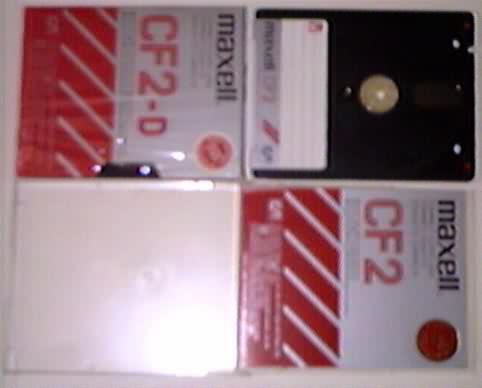
Maxell, like other manufacturers, distinguished between CF2 and CF2DD discs. Actually they were made in the same production, only the labels differ. The common sales-argument was that the CF2DD was tested and certified to work in the double-sided disc drive. The corresponding price ranged from NLG 10 up to NLG 20!
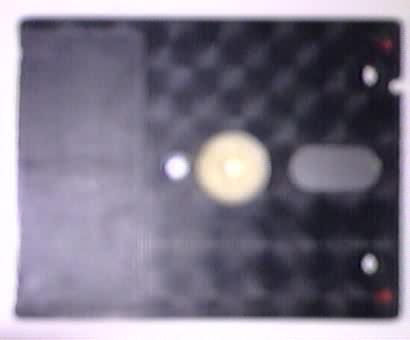
An example of a white-label disc of lesser quality (to put it mildly). The surface has a circular pattern and the weight is 24 grams (6 less than the Panasonic). It is a bit too small as well and, upon formatting, losses can amount up to 10%. Sometimes they are very noisy when run in a 3" drive and they are definitely not my favourite. They were sold in plastic bags, packaged in silver coloured cardbox boxes, per 5. Nevertheless, the ones that survived the formatting are still in operation: 15 years, so they are not that bad as others. Others, like the specimen without felt pieces inside or without the shutter plates that cover the floppy disc. Those did not survive the years...
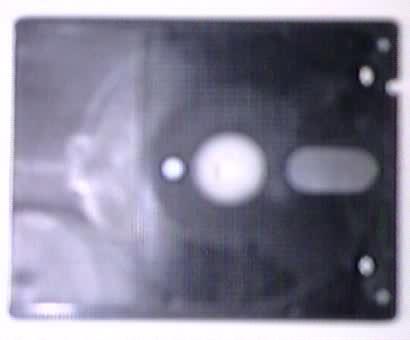
Another example of a bad quality disc: Panasonic styled surface, Maxell type R/W slide. A white-label, non-branded one, as well. In spite of the poor quality of the picture, the imprint of the circle from the 3" floppy is clearly visible on the outer surface of the cover! Potential throw-away that resided forgotten on a deep shelf in one of my closets.
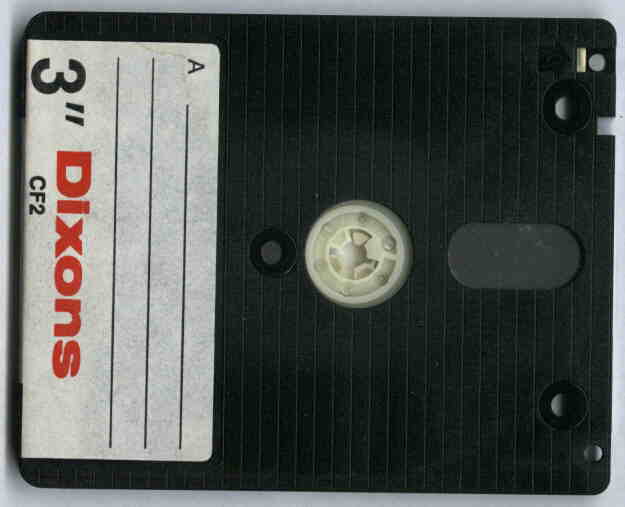
A disc with the label of Dixons (although the manufacturer is Panasonic). Dixons sold CPC's and PCW's in, amongst others, in Holland. In the USA it was the importer of the American computers (featuring 110 volt).

Disk-care. 3" Head cleaning diskette with cleaning fluid. Never used one but I suppose it cannot hurt to clean the drive once in a while.
I use a brush or a vacuumcleaner myself (or blow the dirve clear) to get rid of dust. As stated elswhere, the 3" drive does not suffer from much problems and basically only the drive belt occasionally causes problems (every 5-10 years, that is).
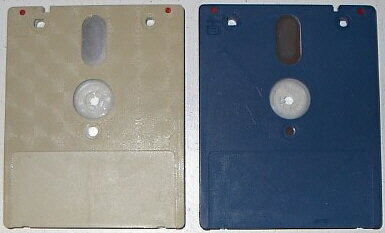
Two examples of colored disks. One is a derivative of the bad-quality disk with the circular pattern, the other one resembles a Maxell but does contain bad sectors (therefore indicating that it is not a Maxell).
Both diskettes are below quality standards and (as I have more than enough disks) will be scrapped.
The
next page continues with the details of logical formats.